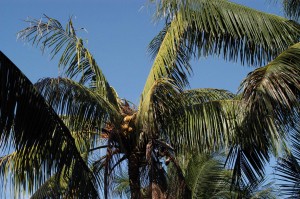- Pathogens: Phytophthora palmivora and Thielaviopsis paradoxa (a.k.a. Chalara paradoxa – see Pest of the Month February 2009 – Stem Bleeding of Coconut)
- Hosts: Fishtail palms, pineapple, coconut, Dracaena fragrans, Ficus spp., Phoenix spp., Rhapis sp., royal palm, cabbage palm, sugarcane, queen palm, Manila palm, Washingtonia spp., aglaonema, Syngonium podophyllum
- Distribution: California, Florida, Arizona, Hawaii, and other subtropical and tropical areas where palms are important landscape plants.
- Symptoms: For palm bud rot, discoloration and wilting of the spear leaf and wilting/discoloration of the next youngest leaf. If severe, the spear leaf will easily pull from the bud. For taller palms, often the first symptom noticed is that no new leaves are being produced. The crown may fall over or snap off (Thielaviopsis paradoxa). For palm trunk rot, the palms fall over with the stem bending about half-way up the bole. The trunk may begin to bleed from small cracks, possibly with a foamy, white fluid that smells like wine or beer. In later stages, the trunk is essentially hollow with stringy tissue left inside while the outside appears normal.
- Diagnosis: Laboratory diagnosis is necessary to determine which pathogen is causing the symptoms.
- Spread by: Contaminated tools; contaminated soil; rain/irrigation splashing spores; flooding; movement of spores by insects, snails, or rodents.
- Management: Remove and destroy the palms, roots and all, and replace the soil in the planting hole with clean soil. Replant with non-susceptible species. Avoid mechanical injury. Disinfect tools. Treatment with either Benlate (Benomyl) or Cleary’s 3336 (thiophanate methyl) for palm trunk rot that is not severe.
Sources:
Bud Rots of Palms, Monica L. Elliott, University of Florida, IFAS Extension PP-220, January 2006, revised January 2009.
Thielaviopsis Bud Rot of Palms, J.F. Garofalo, University of Florida, Miami-Dade County Fact Sheet No. 22, January 1999.

